
Knapp barn
Do you ever have a photograph that you want to paint but you want to make it yours and aren’t sure how to go about changing it? I have an approach that you may like. I call it, “The good, the bad, and the ugly.”
Take, for example, this photo. It is of a historic barn on Orcas where a class had gathered and it was the chosen subject.
The Good:
- The shape of the barn is interesting
- This angle is pleasing
- The light is good and the shadows are creating a good value pattern
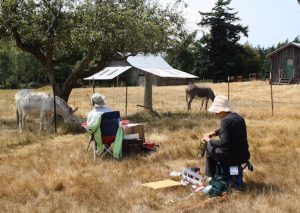
painting at Knapp’s farm
The Bad:
- Boring foreground
- Second building not helping
- Somewhat lifeless
The Ugly
- Middle fir calling too much attention to itself for background
- Grass dull
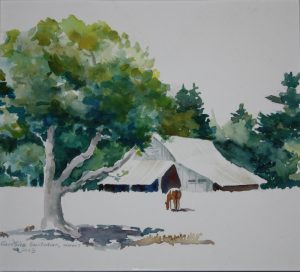
The Old Knapp Barn
You can see my solution. I overlapped the building on the left with an old apple tree and placed a grazing horse in a pivotal position. The wild fir is calmed. building on the right eliminated.
I think the painting captures both the heat of the summer sun and a sense of calm contentment. There is a light wash in the sky and none on the grass to emphasize the brightness of the sun.

hammock on a summer day
Lets try it again.
This is a photo of a hammock strung between madrona trees and on a point I rowed past daily when we kept my rowboat on this side of the island.
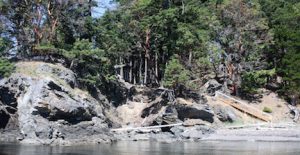
later photo of the rocks and start of the beach
It looked like a great place to hang out and I decided to try and paint it. There are rugged rocks on the point. Next to the point is a private beach.

another angle, another light
The Good
- Hammock in dabbled shade between madronas
- Calls to you to come and relax
- Peaceful
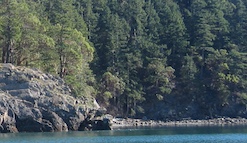
another angle
The Bad
- a confusion of trees and rocks
- hammock and beach not connected
- rocks keep you away from the hammock
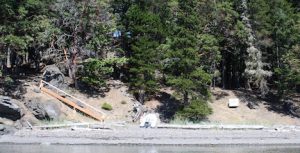
the beach in the sun
The Ugly
- rocks are not restful looking
- some clutter, not peaceful
The first painting I tried was to faithful to the rocks. People would say, “Those are really great rocks.” They were keeping the viewer away from the hammock so I drew them as less imposing and let them lead us up to the hammock.
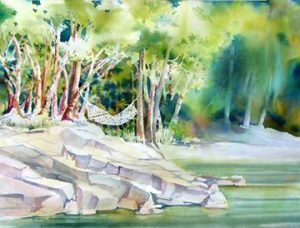
The Hammock Beckons
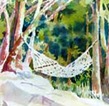
focus, detailed trees
On purpose the trees moving away from the hammock on the right become more and more impressionistic – to control the focus and keep the mood tuned to relaxing. This painting captures the feelings I had as I passed by this spot.
How do you make these decisions? First ask yourself WHY you want to paint this scene (the hammock calls to me). Then – start drawing. Try out various ideas.
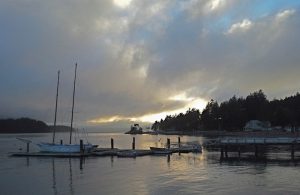
schooner, winter sunset
This is a photo I would like to use to do a painting. Below is an articulation of my thinking about it.
The Good:
- Dramatic late winter sky
- Tranquil water scene with lovely reflected light
The Bad:
- The boat seems to be facing the wrong way
- The small islet is a competitive attention grabber cf. to the schooner
- Boat same value as the water around it
The Ugly:
- Too much “stuff” or weight to the right
Start drawing:
- Turn the boat around so the bow is moving into the nicest light
- Scoot the whole right land mass to the right and a bit lower so there is more room for the colors in the sky and water and the the islet is about a third of the way in from the right
- Eliminate about 1/2 of the land mass on the right edge
- Increase the drama in the sky with more value change
You will find that when you have a sketch with proportions that seem right, you are ready to draw it up.
By the time you have drawn your choice for a painting in a number of small sketches you KNOW what is the good. You become comfortable changing/deleting the bad and the ugly. You exploit what is good, reduce it to simple strong shapes that tell your story and eliminate the bad and the ugly. In the process it becomes your painting.
Hope this helps you. Now I need to start drawing!
Happy painting!
Caroline
